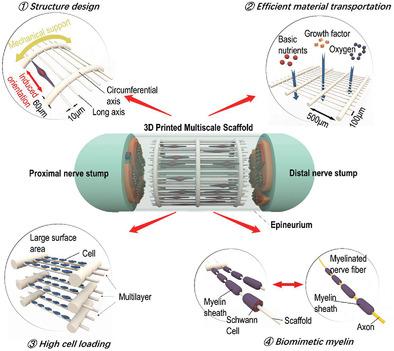当前位置:
X-MOL 学术
›
Adv. Funct. Mater.
›
论文详情
Our official English website, www.x-mol.net, welcomes your
feedback! (Note: you will need to create a separate account there.)
Peripheral Nerve Regeneration with 3D Printed Bionic Scaffolds Loading Neural Crest Stem Cell Derived Schwann Cell Progenitors
Advanced Functional Materials ( IF 18.5 ) Pub Date : 2021-02-17 , DOI: 10.1002/adfm.202010215
Ying Li 1, 2 , Shang Lv 3, 4 , Huipu Yuan 1, 2 , Gang Ye 5 , Wenbo Mu 1, 2 , Yong Fu 6 , Xuan Zhang 7 , Zhiying Feng 8 , Yong He 3, 4 , Wei Chen 1, 2, 9
Advanced Functional Materials ( IF 18.5 ) Pub Date : 2021-02-17 , DOI: 10.1002/adfm.202010215
Ying Li 1, 2 , Shang Lv 3, 4 , Huipu Yuan 1, 2 , Gang Ye 5 , Wenbo Mu 1, 2 , Yong Fu 6 , Xuan Zhang 7 , Zhiying Feng 8 , Yong He 3, 4 , Wei Chen 1, 2, 9
Affiliation

|
Peripheral nerve injuries are one of the most common types of traumatic damage to the nervous system. Treatment of peripheral nerve injuries aims to promote axon regrowth by imitating and improving the microenvironment for sciatic nerve regeneration. In this study, regeneration efficiency and behavior of peripheral nerves are compared under three treatment strategies: 1) transplantation of Schwann cell progenitors induced from purified neural crest stem cells; 2) implantation of a multiscale scaffold based on high‐resolution 3D printing; and 3) implantation of this bionic scaffold loading Schwann cell progenitors. The results of structural, electrophysiological, and behavioral tests demonstrate that the three treatment strategies result in different degrees of regeneration. The purified neural crest stem cells differentiate into functional Schwann cells and promote axon regeneration. The multifunctional 3D printed scaffold promotes oriented growth and myelination, and the myelinated nerve regrows with increased density and without visible scaffolds after six months. For the regeneration, scaffold treatment produces better performance than cell graft alone. Finally, it is shown that implantation of multiscale scaffolds preloaded with neural crest stem cell derived Schwann cell progenitors is the best strategy to promote peripheral nerve regeneration with improved anatomy and function among the three different strategies.
中文翻译:

用3D打印的仿生支架加载周围神经再生的神经rest干细胞衍生的雪旺细胞祖细胞
周围神经损伤是对神经系统的最常见的损伤类型之一。周围神经损伤的治疗旨在通过模仿和改善坐骨神经再生的微环境来促进轴突再生。在这项研究中,比较了三种治疗策略下的再生效率和周围神经的行为:1)纯化神经purified干细胞诱导的雪旺氏细胞祖细胞移植;2)植入基于高分辨率3D打印的多尺度支架;3)植入这种仿生支架中的施旺细胞祖细胞。结构,电生理和行为测试的结果表明,三种治疗策略可导致不同程度的再生。纯化的神经c干细胞分化为功能性雪旺氏细胞并促进轴突再生。多功能3D打印支架可促进定向生长和髓鞘形成,并且六个月后,带髓鞘的神经再生会增加密度,并且没有可见的支架。对于再生,支架治疗比单独的细胞移植产生更好的性能。最后,表明在三种不同的策略中,预载神经neural干细胞衍生的雪旺氏细胞祖细胞的多尺度支架植入是促进外周神经再生,具有改善的解剖结构和功能的最佳策略。六个月后,有髓神经再生长,密度增加,没有可见的支架。对于再生,支架治疗比单独的细胞移植产生更好的性能。最后,表明在三种不同的策略中,预载神经neural干细胞衍生的雪旺氏细胞祖细胞的多尺度支架植入是促进外周神经再生,具有改善的解剖结构和功能的最佳策略。六个月后,有髓神经再生长,密度增加,没有可见的支架。对于再生,支架治疗比单独的细胞移植产生更好的性能。最后,表明在三种不同的策略中,预载神经neural干细胞衍生的雪旺氏细胞祖细胞的多尺度支架植入是促进外周神经再生,具有改善的解剖结构和功能的最佳策略。
更新日期:2021-04-15
中文翻译:

用3D打印的仿生支架加载周围神经再生的神经rest干细胞衍生的雪旺细胞祖细胞
周围神经损伤是对神经系统的最常见的损伤类型之一。周围神经损伤的治疗旨在通过模仿和改善坐骨神经再生的微环境来促进轴突再生。在这项研究中,比较了三种治疗策略下的再生效率和周围神经的行为:1)纯化神经purified干细胞诱导的雪旺氏细胞祖细胞移植;2)植入基于高分辨率3D打印的多尺度支架;3)植入这种仿生支架中的施旺细胞祖细胞。结构,电生理和行为测试的结果表明,三种治疗策略可导致不同程度的再生。纯化的神经c干细胞分化为功能性雪旺氏细胞并促进轴突再生。多功能3D打印支架可促进定向生长和髓鞘形成,并且六个月后,带髓鞘的神经再生会增加密度,并且没有可见的支架。对于再生,支架治疗比单独的细胞移植产生更好的性能。最后,表明在三种不同的策略中,预载神经neural干细胞衍生的雪旺氏细胞祖细胞的多尺度支架植入是促进外周神经再生,具有改善的解剖结构和功能的最佳策略。六个月后,有髓神经再生长,密度增加,没有可见的支架。对于再生,支架治疗比单独的细胞移植产生更好的性能。最后,表明在三种不同的策略中,预载神经neural干细胞衍生的雪旺氏细胞祖细胞的多尺度支架植入是促进外周神经再生,具有改善的解剖结构和功能的最佳策略。六个月后,有髓神经再生长,密度增加,没有可见的支架。对于再生,支架治疗比单独的细胞移植产生更好的性能。最后,表明在三种不同的策略中,预载神经neural干细胞衍生的雪旺氏细胞祖细胞的多尺度支架植入是促进外周神经再生,具有改善的解剖结构和功能的最佳策略。

































 京公网安备 11010802027423号
京公网安备 11010802027423号